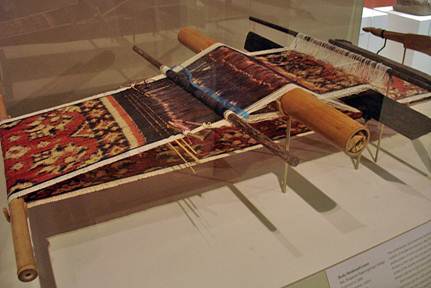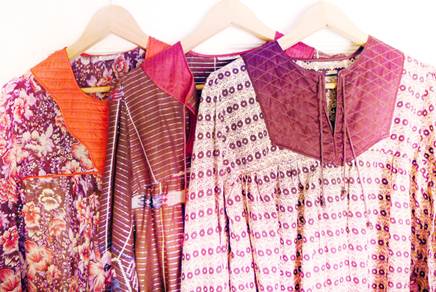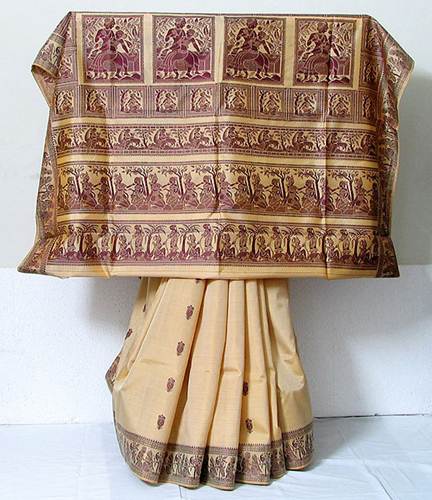My tryst with destiny, or in other words
‘fashion’, began 25 years ago. It led me on a veritable path of discovery of
great, venerable, 2,000 year old treasure troves of Indian textile and craft
traditions dating back from the Rig Vedic Period, the Kushan Period, the madly
exciting Mughal Age and finally to a very modern independent India. I first
used Ikat weaves on the runway in the ’80s and heads turned. Today, I continue
in my exploration of textiles with the same passion.

It
led me on a veritable path of discovery of great, venerable, 2,000 year old
treasure troves of Indian textile
Take a trip with me to the ikat belt of
India, one of the finest and largest in the world. This is a tie and dye
technique employed to pattern textiles that use a resist dyeing process on
either the warp (yarns placed vertically on a loom) or weft (the horizontal
threads that weave in and out). Odissi weaves like Sambhalpuri and Bichitrapuri
are legendary and use traditional motifs that emerge from the region like the
shankh (conch), rudraksha (holy beads), matsya (fish) and padchinh (feet). In
the land of the Lord Jagannath, calligraphy weaves from the Puri temple, woven
images of deities and the 12th century Oriya poet Jaideva’s
extremely popular Geeta Govinda in local vernacular script are a collector’s
delight. I literally live, breathe and worship ikat, whether from Orissa,
Andhra Pradesh or the double ikat from Gujarat.

the
ikat belt of India, one of the finest and largest in the world
Further south, on the same belt, we
discover kalamkari in Andhra Pradesh with its veritable figurative or floral
paintings on fabrics like khadi and mangalgiri. Painted with a pen brush using
natural dyes derived from indigo, iron rust and katha, each painting is created
to tell folklore. Epic scenes from the Ramayana and Mahabharata find their spot
while the mythical tree of life has become an iconic motif on its own. The two
styles to look out for are the Srikalahasti school of art and the more commonly
seen one from Machlipatnam, a centre that flourished under the patronage of the
Golconda Sultanate. While in the state, go west to the Godaveri and look out
for uppada saris. A flat weave woven in pure gold zari, this fabric takes
influences from tribal myths.

Kalamkari textiles
Block prints with motifs are done by the
followers of great poet and philosopher Kabir (1414- 1518), who was also a
handloom weaver and rangrez or dyer of textiles. This is a profession passed on
through generations of his followers.
My fondest memories, however, go back to
1987, a year where I fused two distinct weave traditions: baluchari weaving
techniques from West Bengal with the extremely traditional kalakshetra motifs
of Tamil Nadu. Call it a new swadeshi identity, but this is when I knew that
textiles were my forte and the idea to use weave as a form of embellishment in
Indian fashion took off. A fabric that is being reintroduced is the flexible bamboo,
produced mostly in the northeastern states.

baluchari
weaving techniques from West Bengal
So far, I have experimented with textiles
from all over the subcontinent to create my version of undivided India. One
such challenge took me to Bangladesh on work with BRAC, an NGO. We worked on
reviving nakshi-kantha and the legenday dhakai muslin, a favourite of the
Mughal empress Noor Jehan (1577-1645). This woman should be credited with the
flourishing of creativity in textile. She brought to court kalamkari and
introduced the embroidered threadwork of zardozi and chikankari to royalty.
Textiles, like geographical terrain, change
their shades, textures and techniques as you travel from one region to another.
They are linked to the fabric of life, to community, to nature and traditions.
In many ways, they are a sharp reflection of the community’s indigenous
identity. Every weave tells a story that textile lovers like me absorb and then
interpret them for the world to enjoy.